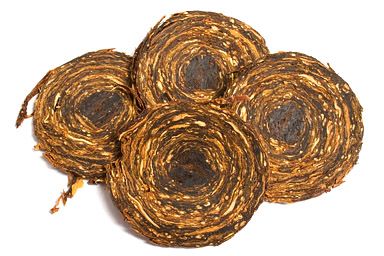The sailors wanting to preserve their tobacco on long hauls often packed sugar barrels or rum barrels full with the stuff only to find that the tobacco took on traits of the rum or sugar. The sugar smooths the tobacco out and makes the nicotine release slower and the rum adds a nice light taste.
Also a common method of tobacco manufacture was to make ropes which are leaves wound around and around each other into a rope about an inch or two thick and left to marry.
Wiki definition;
Navy Flake, Navy cut, Navy tobacco is a Burley leaf pipe tobacco. In colonial times sailors twisted tobacco into a roll and "tied it tightly, often moistening the leaves with rum, molasses, or spice solutions." Stored in this way the flavors melded. To smoke it a slice was cut, known as a "twist" or "curly". Eventually all twisted tobacco, and then pressed tobacco, became known as "Navy" "because of the convenience for sailors and outdoorsmen who favored its compact size "and long-lasting, slow-burning qualities." Navy Flake tobacco is pressed into bricks and sliced into broad flakes.
Examples of Navy pipe tobacco are;
Mac Baren Navy Flake - Burley with Virginia and Cavendish
tobaccos. (Honey and rum casing)

Samuel Gawith - Navy Flake - Virginia and Latakia (Rum Casing)

Dunhill - De Luxe Navy Rolls- Virginia and Perique (No casing listed but it would almost definitely have molasses casing)

Now there are more examples but I'll leave it there for now as this shows that each variation has it's own Tobacco blend and taste completely different to each other.
The Dunhill Navy rolls tend to use the word 'Navy' as a demonstration of form, ie cut coins from a roll, opposed to the use of rum in it's casing. Whereas MacBaren actually use the word 'Navy' because they use rum as a casing opposed to the tobacco being in rope/coin form.
So if wanting to try a Navy tobacco be sure to read the tin and see what you're getting. They are all excellent so you won't go wrong but you may like one sort better than the other and it always helps to know why.

